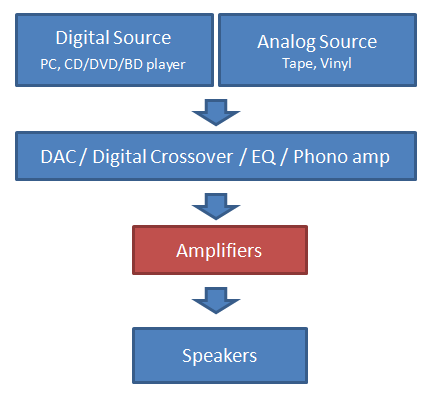|
All About Audio AmplifiersWhat are audio amplifiers? To make it simple, it is a device for increasing the power or level of a signal. In our context here, it is the device to take the input from audio source and produce sound over the speakers. There are many types of amplifiers. It is categorized into what they’re used for, like microphone, guitar, audio, IF, RF, video amplifier, and etc. What we’re focusing here are all about audio amplifiers! How to differentiate, understand and even DIY it to drive our beloved speakers.
There are basically two camps of amplifiers – vacuum tube (valve) and solid state (semiconductor) based amplifiers. Vacuum tube based amplifiers are gaining popularity as many claim the unique sonic characteristics that make them more listenable, warm and analog sounding compare solid state based amplifiers. I myself am a supporter of both, where I would like to mix both technologies in the audio chain.
Vacuum tube, electron tube, or thermionic valve, are devices used in the older days to amplify, rectify, regulate, change, or switch electrical signals by controlling the current or electrons in a vacuum space. Some vacuum tubes are filled with gas to generate certain electrical characteristics too. Vacuum tube amplifiers are usually discrete since there are no integrated vacuum tube circuits. Examples: triodes, tetrodes, pentodes, diodes, rectifiers, regulators, nixies and etc.
Solid state devices are components made up from solid materials instead of vacuum space where the current or electron flows and being controlled entirely in the solid matter itself. These devices are usually crystalline conductors, insulators and semiconductor, made up of silicon and other materials. Some solid state amplifier uses discrete components to build up the amplifier and some uses integrated circuits (IC) to do the job. Examples: Opamp, MOSFET, J-FET, FET, BJT, diode, rectifier, voltage regulator, and etc. There is also a camp called the hybrid amplifiers. It mates solid state devices and vacuum tubes to form a hybrid amplifier. The combination could be vacuum tube pre-amplifier and solid-state power stage; or solid-state pre-amplifier and vacuum tube power stage (rarely this case but is possible). It can be housed in a single chassis or separate into pre-amplifier and power amplifiers. This will have the best of both worlds as usually vacuum tube is associated with tone and solid-state is with drive or power. There are several basic categories of audio amplifier too.
Well, this concludes the 10,000ft introduction of audio amplifiers! We shall dwell deeper in near future. Stay tuned! Ken 3/22/2011 Return from Audio Amplifiers to DIY Audio Guide For more details about amplifiers specifically for headphones, click here to leave this website to Best Headphone Review (open in a new window).
|




